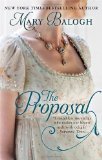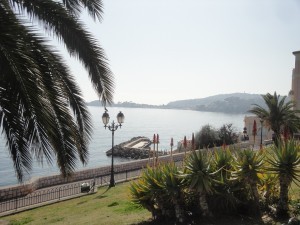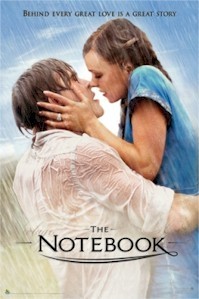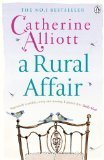Hannah Fielding's Blog, page 141
December 6, 2012
Book Review: The Proposal (The Survivors Club #1) by Mary Balogh
From the blurb:
Lady Gwendoline Muir has experienced her fair share of tragedies in her short life: she lost her husband to a freak accident and developed a limp after falling from horseback. Still young, Gwen is sure that she’s done with love and that she will never be married again.
Gwen tries to be content with her life as it is and to live through the happy marriages of her brother and her best friend, Viscountess Ravensberg. She’s happy for them and for years that is enough for her . . . until she meets Lord Trentham – a man who returned from the Peninsula Wars a hero but is unable to escape the bite of his survivor’s guilt. For he might just be the man who can convince her to believe in second chances.
This is the first book in a new series – The Survivors’ Club – by Mary Balogh. The ‘survivors’ are six men and one woman who were all in one way or another affected by the recent Napoleonic Wars. All six recuperated after the wars at Penderris Hall in Cornwall, where they healed their physical or emotional wounds. During this time they developed a close friendship, and before they left to rebuild their lives they committed to returning to Cornwall each year for a few weeks.
This first book deals with the story of Hugo Emes, Lord Trentham, born and raised in the middle class, who was awarded his title after leading and surviving a Forlorn Hope in the war. A stern, moody and somewhat blunt man, Hugo is unable to escape his guilt over surviving the war and is uncomfortable with his elevated status; he dreams of a quiet life in the country. But Hugo has recently inherited his father’s considerable business and fortune, and Hugo promised his dying father he would pass the business on to his own son, and look after his half-sister, Constance, too. Hugo has realised that he cannot achieve either of these aims by himself, so this year he has come to Cornwall to seek advice from his friends on how to find a wife.
Gwendoline Grayson, Lady Muir, is staying in the same village in Cornwall, visiting a recently widowed friend. Gwen is not a new character to fellow previous readers of Mary Balogh’s books. She has been a minor character in the stories of her brother and sister-in-law (One Night for Love and A Summer to Remember), who also appear in this book. Like Hugo, Gwen has had her fair share of tragedy; a widow herself for several years, her husband suffered from severe depression following the loss of their unborn child in a horse riding accident. Gwen has since been content to be alone, living through her family, but recently she has been feeling lonely, and has been considering looking for a husband for companionship. Gwen is out walking on the beach one day when she stumbles and sprains her ankle. Hugo spots her, and carries her back to Penderris Hall, where she stays for a week to recuperate. The chemistry, beautifully described, is evident at once:
Gwen glanced at Lord Trentham, who was silently sipping his tea, his dark eyes resting on her. He was, she thought in some surprise and with a little shiver of awareness, a terribly attractive man. He ought not to be. He was too large to be either elegant or graceful. His hair was too short to soften the harshness of his features or the hard line of his jaw. His mouth was too straight and hard-set to be sensuous. His eyes were too dark and too penetrating to make a woman want to fall into them. There was nothing to suggest charm or humor or any warmth of personality. And yet… And yet there was an aura about him of almost overpowering physicality. Of masculinity.
The story follows Hugo and Gwen as their relationship develops and they explore whether it is possible for two people from two completely different backgrounds, both so eaten up by their own internal anguish, to find middle ground where they can be together – and if they even want to be together at all. The author takes you from the London season and balls of the stiff and rule-driven upper classes to the working life and struggles of the middle and lower classes in both London and the country, providing a broad look at life in England during the era.
The book is expertly written from both Hugo and Gwen’s perspectives, sometimes going over the same situation twice and allowing the reader to fully understand why the two characters behave in the way they do. I agree with Gwen: there is definitely something about Hugo, something Mr Darcy-esque. He is a complicated man with several layers, and despite your head telling you that you shouldn’t like him, your heart won’t listen. I really enjoyed reading about these two characters as they dealt with their own internal demons, their complicated families and class structures, and their decisions about whether to take a chance in love – and the author’s wonderfully warm way of conveying these themes:
… no one could tell you about love or romance or what would happen if you married and the romance dwindled away. You could only find out for yourself. Or not find out. You could face the challenge or you could turn away from it. You could be a hero or a coward. You could be a wise man or a fool. A cautious man or a reckless one. Were there any answers to anything in life? Life was a bit like walking a thin, swaying, fraying tightrope over a deep chasm with jagged rocks and a few wild animals waiting at the bottom. It was that dangerous–and that exciting. Arrgghh!
This book also sets the scene nicely for the following books on the other six members of The Survivor’s Club, which I very much look forward to reading.
The Proposal is available now from Amazon; click on the book cover below to visit the store.
December 4, 2012
A view to get the creative juices flowing
December 3, 2012
Ten Romantic Winter Dates
At my home in Kent, where I’m ensconced until the New Year now, it’s beginning to look a lot like winter – frost on the lawn, ice-encrusted puddles, clouds of breath misting the early morning, fires stoked all day long. Having grown up alongside the Mediterranean in a warm country, I confess that the cold seems to penetrate right to my bones. Yet this time of year holds such festivity and ambiance, I cannot resist its allure. An English December is, for me, the very height of romance. So today, I’m sharing with you ten romantic dates for winter, making the best of this season and celebrating all the wonder and romance that it can bring, beyond a runny nose and ice-block feet!
A long walk in the open air: Woods or fields, park or beach – whatever landscape appeals to you, pull on those boots, wrap up in layer upon layer of winter woolies and head out into the bracing air. Hold hands as you admire nature and reminisce, steal a kiss in a leafy corner and then return home, pink-cheeked and nicely tired, for a cup of warming hot chocolate.
A romantic meal by candlelight: With the nights drawing in by mid-afternoon, you can set a warm, romantic scene for an early supper, or save it for a later meal. A table with two seats set intimately, candles flickering on every surface, some mood music and a delicious, hearty meal – the perfect backdrop before which a touching scene can unfold.
A visit to a Christmas market: What woman doesn’t love a shopping trip? But most men find the experience something to grumble about, rather than a romance-inducing event. A traditional Christmas market has such atmosphere, though, and even the grumpiest of shoppers will melt here, with a glass of mulled wine, a hot mince pie and perhaps even accompanying Christmas carols from a brass band. Before you know it you’re heading home with a bag of artisan-created presents, a warm stomach and a singing heart.
A drink at an olde worlde pub: On a cold winter’s evening or afternoon, slip away from the hustle and bustle of Christmas shoppers and nestle down in a cosy corner of a traditional pub. The more original features – fireplaces, beams, cubbies – the more heightened the romantic mood. Best of all, seek out a quirky inn. I once had a wonderfully atmospheric drink at Ye Olde Trip to Jerusalem, England’s oldest inn, which is built into the caves under Nottingham Castle.
A long lay-in: When bed is the warmest, snuggliest place to be, why go anywhere at all? Take a duvet day, tucking yourself in with snacks and drinks and books and music, then spend the day dreaming together.
A trip to see the Christmas lights: Who can fail to get a warm glow when gazing at twinkling, magical Christmas lights? Suddenly, you’re a child again, full of wonder. Take a trip to your local town or city, or head to London for really atmospheric sights.
A classic movie: In the run-up to Christmas all the major channels run through their back catalogue of films, and you can rediscover some golden oldies that transport you to the most wonderful, romantic bygone eras. It’s a Wonderful Life is a favourite for me.
A home-baking afternoon: We may not be bears, but we humans hibernate somewhat in winter – home calls, and with it delicious comfort food. Lead your partner to the kitchen, don an apron and spend a happy afternoon surrounded by the smells and tastes of baking: mince pies, gingerbread, Christmas cake – whatever takes your fancy. And if a flour fight should ensue, well… what’s a little mess when you’re laughing together?
A visit with loved ones: ’Tis the season to be jolly – and sociable. Be hospitable and open your home to friends and family, and make the effort to visit those stuck at home. Although romance is traditionally associated with alone time, in fact being with others can kindle loving feelings too – as you gaze across the room and see your partner patiently laughing at Aunt Morag’s terrible joke, and your heart squeezes as you think how much you love them.
A night in before a roaring fire: Last, but certainly not least. A real fire awakens something primitive inside, and creates such ambiance. The smell, the crackling, the heat, the soft and flickering light – they’re all natural aphrodisiacs. Heavenly!
Can you add to this list? What would be your ideal wintry date? I’d love to hear your thoughts.
December 1, 2012
Calling all romance authors: Guest posts and author interviews invited
I’ve been reviewing books for some time now, and I’ve been publicising my own book, Burning Embers, on various blogs thanks to the generous support of some wonderful book bloggers. I’m keen to return the favour and help out fellow romance authors, so I’ve decided to open up my own blog to guest posts and interviews.
Here are the terms:
I will consider approaches from authors of romance only.
I will consider both self-published and traditionally published authors.
I reserve the right to choose whom I feature on the blog.
I welcome book review requests; again, I reserve the right to choose which I review.
If you’d like to discuss featuring an interview, guest post or review on my website, please contact me at burning-embers at hotmail dot co dot uk.
November 30, 2012
Rain: Dreary romance dampener, or perfect passion producer?
Recently, it has been raining rather a lot in England, and we’ve had terrible flooding as a result. The skies are dark, the ground is soggy and I find myself housebound, reluctant to venture out beneath clouds that leave me damp and shivering. The cold I don’t mind; but having grown up in Alexandria, where the climate is arid and rain is a rarity, I find it difficult to embrace the rain that’s so common in England.
When I write romance stories, I naturally think of settings that are light and warm. It is little wonder, then, that I set my debut novel Burning Embers in Kenya. But can rain create a romantic mood just as well? I wondered. I decided to ponder the question, and when I did, I realised that my most lasting impression of bad weather in stories had been of the Shakespearean King Lear, grief-stricken and quite mad, raging at the elements:
Blow, winds, and crack your cheeks! rage! blow!
You cataracts and hurricanoes, spout
Till you have drench’d our steeples, drown’d the cocks!
You sulphurous and thought-executing fires,
Vaunt-couriers to oak-cleaving thunderbolts,
Singe my white head! And thou, all-shaking thunder,
Strike flat the thick rotundity o’ the world!
Crack nature’s moulds, all germens spill at once
That make ingrateful man!
Rain, for me, was very much a negative, compounded by language like ‘drenching’ and ‘drowning’. But then I cast my mind back to books I’ve read and films I’ve seen, and I realised that there’s a second manifestation of rain – as a rather romantic, even sensual catalyst for the connection of two lovers. For example, there are some wonderful examples of climactic kissing scenes in movies between rain-drenched characters; take the last scene of Breakfast at Tiffany’s or the seminal scene from The Notebook (if rainy kisses make you melt, take a look at http://www.ranker.com/list/the-20-most-romantic-kisses-in-the-rain-in-movie-history/brian-walton where you can watch 20 scenes from movies). And the successful romance saga Twilight is set in ‘the wettest place in the continental US’.
So what is it about rain that can create the atmosphere for romance? I think perhaps it is the stripping down of barriers: your hair, carefully styled; your makeup, carefully applied; your clothes, carefully chosen – all are ruined, insignificant, and only a raw essence of the self remains. You’re wilder, more attuned with nature, carefree – you’re wet, you realise, and then you figure there’s nothing more to lose; bring it on. Such an attitude is of course conducive to passion. And what’s not to like in a partner who’s similarly dishevelled? As the soaked Colin Firth demonstrated in the BBC adaption of Austen’s Pride and Prejudice, a man with clothes sticking to him is a sight to behold…
November 29, 2012
Book review: A Rural Affair by Catherine Alliott
From the blurb:
‘If I’m being totally honest I had fantasized about Phil dying.’
When Poppy Shilling’s bike-besotted, Lycra-clad husband is killed in a freak accident, she can’t help feeling a guilty sense of relief. For at long last she’s released from a controlling and loveless marriage.
Throwing herself wholeheartedly into village life, she’s determined to start over. And sure enough, everyone from Luke the sexy church organist to Bob the resident oddball, is taking note. Yet the one man Poppy can’t take her eyes off seems tantalizingly out of reach – why won’t he let go of his glamorous ex-wife?
But just as she’s ready to dip her toes in the water, the discovery of a dark secret about her late husband shatters Poppy’s confidence. Does she really have the courage to risk her heart again? Because Poppy wants a lot more than just a rural affair . . .
My favourite thing about writer Catherine Alliott is the strong author voice that is entirely consistent across her books. When I pick up a Catherine Alliott, I know to expect lively, realistic romance with a hint of humour, and A Rural Affair does not disappoint.
I read the book over several days, and found myself looking forward to picking it back up and reading on. There’s a strong sense of setting – a rural English village – and a great cast of characters who reminded me a little of the cast of The Vicar of Dibley. The story extends beyond the main character, Poppy, and her efforts to come to terms with widowhood and some nasty truths about her former husband, and follows three other women who are also encountering troubles in love: one has been left by her husband – can she forgive his affair?; another is a widow whose never found a man to measure up to the memory of her lost love; and the other is the harrassed best friend trying to keep her marriage on the straight and narrow and bring up three children. Together, the four stories intertwine to create an interesting and lively book.
I very much like the author’s writing style, which is well-crafted and tightly constructed, but for me it’s both the poignant and the laugh-out-loud moments of this book that stand out, from Poppy’s depression as she discovers a web of deception, to her escapades on an unruly horse at the local hunt and following one too many schnapps at a grand party.
The ending is satisfying – it is just what you want from a romance book. I’d have loved an epilogue to take the romance a step further, but as it stands, it’s a great, upbeat ending.
All in all, a wonderful read for touching sentiment, super laughs and likeable characters – great escapism for a chilly autumnal day.
A Rural Affair is available now from Amazon; click on the book cover below to visit the store.
November 27, 2012
Fishing boats on Deal’s shingle shore
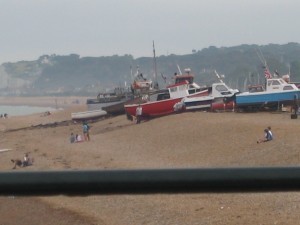 I love to take walks on the beach here. At this time of year, the sea air is bracing and refreshing, and it’s divine afterwards to get home to a warm house and a hot drink.
I love to take walks on the beach here. At this time of year, the sea air is bracing and refreshing, and it’s divine afterwards to get home to a warm house and a hot drink.
November 26, 2012
Ten top romantic musicals
There is something magical about a musical. Music has such power to create a reaction, and done well, I think a musical form of a romance can really heighten the connection to the characters and the emotional charge of the story.
I am a very visual writer, and when I write I often picture scenes as they are in reality – or on the big screen of the Hollywood Golden Era, or the stage. I imagine that a musical version of Burning Embers would have a wonderful mix of music, from the thrumming drum beats and chants of the native music, to the exotic, sensual tones of the music to which people dance at Rafe’s nightclub, to touching and stirring ballads sung by Rafe and Coral.
If, like me, you love to be swept away in high romance, then I’m sure you will enjoy the following musicals, either on stage or in film format. For me, the old ones are the best – but with a new adaptation of Les Misèrables due out in January featuring the very dashing High Jackman and Russell Crowe, I may well be convinced otherwise…
The Phantom of the Opera: Live is best, I think, but the 1994 film was wonderfully atmospheric and dramatic, and Gerard Butler made for a smouldering phantom.
West Side Story: A modern-day Romeo and Juliet. Wonderful dancing and fabulous songs (‘Somewhere’ is beautiful), but you’ll need nerves of steel to cope with the ending.
Guys and Dolls: A light-hearted romance with a good deal of poignancy. I love the 1955 screen adaptation featuring Marlon Brando, Jean Simmons, Frank Sinatra and Vivian Blaine.
Moulin Rouge: ‘Come What May’ gives me shivers, and the story itself has the key element of high romance: girl and boy from different worlds fall in love and try to beat the odds to be together.
My Fair Lady: A classic, and the song ‘I’ve Grown Accustomed to Her Face’ never fails to create that warm, fuzzy feeling inside.
Singin’ in the Rain: The chemistry between Gene Kelly and Debbie Reynolds makes for a magical romance.
Funny Face: Who can resist Audrey Hepburn and Fred Astaire, and a score by the Gershwins? Quite simply, s’wonderful.
The King and I: Rogers and Hammerstein at their finest; ‘We Kiss in the Shadow’ makes me melt.
The Sound of Music: Who can fail to be charmed by this simple story of love, set against the backdrop of danger and intrigue?
Gigi: I’ve a soft spot for this musical, I think because of its Parisian setting. It’s most famous for the song ‘Thank Heaven for Little Girls’, but there’s a good deal of romance here too.
What do you think? Which musicals would you add to the list? What’s the one musical you’d go to for a special evening with your loved one?
November 24, 2012
A brief history of romance
As a romance novelist I am, of course, an ardent romantic and the best part of my job is dreaming up romantic scenarios and infusing scenes with romantic details. The word ‘romance’, to me, conjures up images of sunsets and candlelight; wonderous scenery and calm, mellow moods; intimate meals and long, searching looks; electric shivers after a brush of skin on skin; words like ‘heart’ and ‘beautiful’ and ‘forever’.
But what of the romance of yesteryear? How did lovers show their feelings in times gone by? Here are some religious customs that were once de rigueur for courting couples:
Until the emergence of medieval chivalry – Sir Lancelot galloping on his steed to rescue a fair damsel – love was not a fundamental part of marriage; most marriages were arranged. But the rescuing part was a pretty good indication that a man liked a woman!
Seranades and poetry were early forms of wooing. Think of Shakespeare’s Romeo and Juliet and Romeo’s climb to the balcony.
In Norway, when a girl came of age she wore an empty sheath on her belt. A man would show his commitment to her by placing his knife in her sheath.
If you were courting in 16th or 17th century America, you may have partaken in ‘bundling’ with your prospective partner. You shared a bed, fully clothed, with a ‘bundling board’ between you.
Welsh men historically gave intricately carved love spoons to show interest in women.
English gents sent a pair of gloves to those they wished to marry. If the woman agreed, she showed this by wearing the gloves to church.
Perhaps more influential than customs, however, have been legends – those of great lovers in history whose stories we still enjoy today: Cleopatra and Mark Anthony, Napoleon and Josephine, Marie and Pierre Curie, Queen Victoria and Prince Albert, Robert and Elizabeth Browning, Humphrey Bogart and Lauren Bacall. More lasting still are the impressions created by the most romantic love stories of our cultures: Romeo and Juliet, Elizabeth and Darcy, Jane Eyre and Rochester, Lancelot and Guinevere, Tristan and Isolde.
Is romance at its height now, do you think, or did lovers express themselves better in the past? The popularity of romantic historical fiction certainly indicates that many modern-day readers find customs and manners of the past attractive. Which would you prefer – a modern-day date, or an afternoon of old-fashioned courtship? Are there old customs you’d like to see come back? I would love to hear your thoughts.

